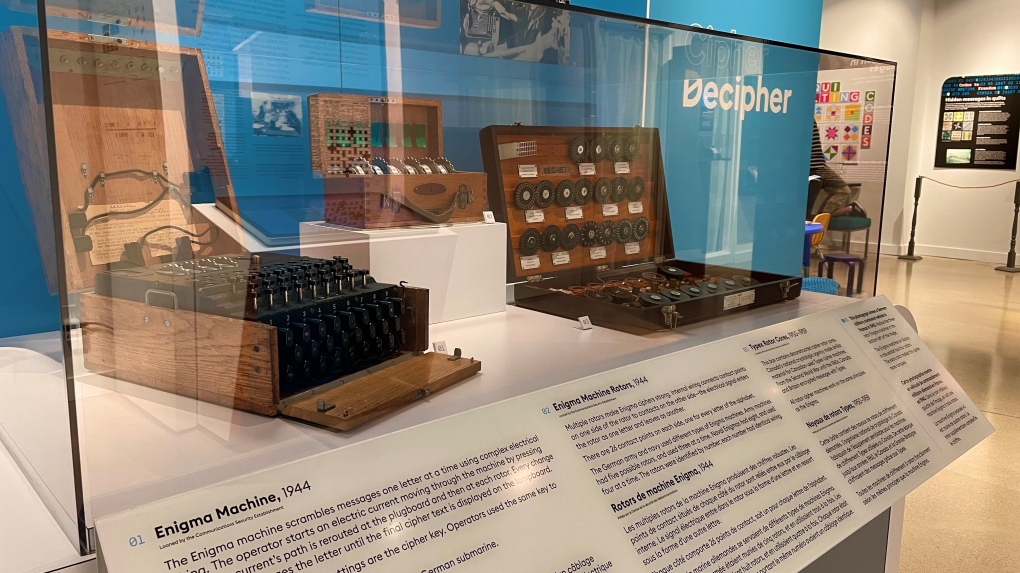Rare Second World War Nazi code machine on display in Waterloo
A new exhibit at the City of Waterloo Museum is inviting visitors to step back in time and crack the code.
An authentic Second World War Enigma machine is now on display at the museum – along with information about the University of Waterloo’s special connection to decoding Nazi messages.
It’s part of Cipher I Decipher, a new travelling exhibit from the Canada Science and Technology Museum.
Retrieved from Nazi-era Germany, the Enigma cipher machine now on display in Waterloo would have been used to send and receive encrypted communications about military movements and strategy.
“Each day the Germans would send out new settings and you would type in your code,” explains Jennifer Huber, museum programs and engagement associate. “It would run through the machine, and it would get each letter encoded nine different times, with the rotors changing after every single letter. So solving that became quite tricky.”
Aside from the rare opportunity to see an authentic Enigma machine, the exhibit showcases other historic communication encryption artifacts like telegraph keys for Morse code.
 An Enigma machine retrieved from a German submarine is on display at the City of Waterloo Museum. (Spencer Turcotte/CTV Kitchener)Visitors can also take a crack at cryptology themselves, ciphering and diciphering their own secret messages.
An Enigma machine retrieved from a German submarine is on display at the City of Waterloo Museum. (Spencer Turcotte/CTV Kitchener)Visitors can also take a crack at cryptology themselves, ciphering and diciphering their own secret messages.
And that’s not all they’ll learn.
“What most people don't know is that Waterloo has their very own codebreaker Bill Tutte,” Huber says.
Tutte is credited with cracking the vastly complicated Lorenz code and helping stop Hitler’s advance.
The University of Waterloo math professor’s cryptanalysis work at Bletchley Park north of London was kept a secret for most of his life.
“There were literally hundreds of other mathematicians and whether they'd be assigned to the project and able to do this --- I don't know,” UW systems design lecturer Scott Campbell says.
Not only was Tutte’s work credited with saving millions of lives, codebreaking on the Lorenz and Enigma machines laid the groundwork for modern cybersecurity.
“This simply solidified the importance going forward for the security agencies in Canada, the United States in Great Britain and around the world,” Campbell says.
You don’t have to look further than Waterloo and BlackBerry to see its influence. The cellphone’s messenger app became the first to protect users’ personal information from end to end.
“There was a transformation in terms of recognizing encryption as vital to the security of these networks,” Campbell says.
So while the Enigma machine left a lot of people scratching their heads throughout history, when it comes to Waterloo’s fingerprint on cracking crucial codes, there’s no mystery.
The Cipher I Decipher exhibition will be at the City of Waterloo Museum until Dec. 29, 2023.
The museum is open Tuesday to Friday from 10 a.m. to 4 p.m. each day.
Admission is free.
CTVNews.ca Top Stories

Indian envoy warns of 'big red line,' days after charges laid in Nijjar case
India's envoy to Canada insists relations between the two countries are positive overall, despite what he describes as 'a lot of noise.'
Former homicide detective explains how police will investigate shooting outside Drake's Bridle Path mansion
Footage from dozens of security cameras in the area of Drake’s Bridle Path mansion could be the key to identifying the suspect responsible for shooting and seriously injuring a security guard outside the rapper’s sprawling home early Tuesday morning, a former Toronto homicide detective says.
Stormy Daniels describes meeting Trump during occasionally graphic testimony in hush money trial
With Donald Trump sitting just feet away, Stormy Daniels testified Tuesday at the former president's hush money trial about a sexual encounter the porn actor says they had in 2006 that resulted in her being paid to keep silent during the presidential race 10 years later.
Alcohol believed to be a factor in boating incident after 2 men die: N.S. RCMP
Two Nova Scotia men are dead after a boat they were travelling in sank in the Annapolis River in Granville Centre, N.S., on Monday.
Northern Ont. woman makes 'eggstraordinary' find
A chicken farmer near Mattawa made an 'eggstraordinary' find Friday morning when she discovered one of her hens laid an egg close to three times the size of an average large chicken egg.
Susan Buckner, who played spirited cheerleader Patty Simcox in 'Grease,' dead at 72
Susan Buckner, best known for playing peppy Rydell High School cheerleader Patty Simcox in the 1978 classic movie musical 'Grease,' has died. She was 72.
Jeremy Skibicki has 'uphill battle' to prove he's not criminally responsible in Winnipeg killings: legal analysts
Accused killer Jeremy Skibicki could have a challenging time convincing a judge that he is not criminally responsible for the deaths of four Indigenous women, a legal analyst says.
Bye-bye bag fee: Calgary repeals single-use bylaw
A Calgary bylaw requiring businesses to charge a minimum bag fee and only provide single-use items when requested has officially been tossed.
CFL suspends Argos QB Chad Kelly at least nine games following investigation
The CFL suspended Toronto Argonauts quarterback Chad Kelly for at least nine regular-season games Tuesday following its investigation into a lawsuit filed by a former strength-and-conditioning coach against both the player and club.




























